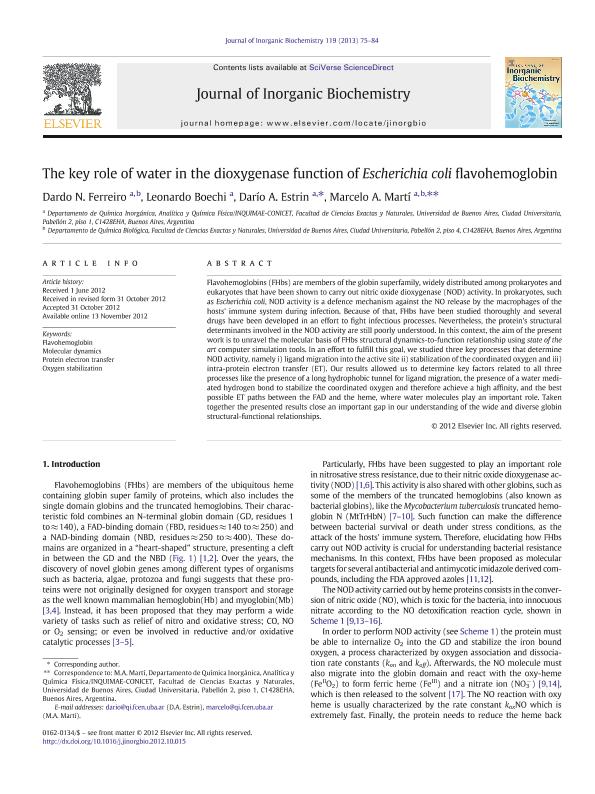Mostrar el registro sencillo del ítem
dc.contributor.author
Ferreiro, Dardo N.
dc.contributor.author
Boechi, Leonardo

dc.contributor.author
Estrin, Dario Ariel

dc.contributor.author
Marti, Marcelo Adrian

dc.date.available
2016-11-03T21:41:39Z
dc.date.issued
2012-11-13
dc.identifier.citation
Ferreiro, Dardo N.; Boechi, Leonardo; Estrin, Dario Ariel; Marti, Marcelo Adrian; The key role of water in the dioxygenase function of Escherichia coli flavohemoglobin; Elsevier; Journal Of Inorganic Biochemistry; 119; 13-11-2012; 75-84
dc.identifier.issn
0162-0134
dc.identifier.uri
http://hdl.handle.net/11336/7968
dc.description.abstract
Flavohemoglobins (FHbs) are members of the globin superfamily, widely distributed among prokaryotes and eukaryotes that have been shown to carry out nitric oxide dioxygenase (NOD) activity. In prokaryotes, such as Escherichia coli, NOD activity is a defence mechanism against the NO release by the macrophages of the hosts´ immune system during infection. Because of that, FHbs have been studied thoroughly and several drugs have been developed in an effort to fight infectious processes. Nevertheless, the protein´s structural determinants involved in the NOD activity are still poorly understood. In this context, the aim of the present work is to unravel the molecular basis of FHbs structural dynamics-to-function relationship using state of the art computer simulation tools. In an effort to fulfill this goal, we studied three key processes that determine NOD activity, namely i) ligand migration into the active site ii) stabilization of the coordinated oxygen and iii) intra-protein electron transfer (ET). Our results allowed us to determine key factors related to all three processes like the presence of a long hydrophobic tunnel for ligand migration, the presence of a water mediated hydrogen bond to stabilize the coordinated oxygen and therefore achieve a high affinity, and the best possible ET paths between the FAD and the heme, where water molecules play an important role. Taken together the presented results close an important gap in our understanding of the wide and diverse globin structural-functional relationships.
dc.format
application/pdf
dc.language.iso
eng
dc.publisher
Elsevier

dc.rights
info:eu-repo/semantics/openAccess
dc.rights.uri
https://creativecommons.org/licenses/by-nc-nd/2.5/ar/
dc.subject
Flavohemoglobin
dc.subject
Molecular Dynamics
dc.subject
Protein Electron Transfer
dc.subject
Oxygen Stabilization
dc.subject.classification
Otras Ciencias Químicas

dc.subject.classification
Ciencias Químicas

dc.subject.classification
CIENCIAS NATURALES Y EXACTAS

dc.title
The key role of water in the dioxygenase function of Escherichia coli flavohemoglobin
dc.type
info:eu-repo/semantics/article
dc.type
info:ar-repo/semantics/artículo
dc.type
info:eu-repo/semantics/publishedVersion
dc.date.updated
2016-10-25T19:28:32Z
dc.journal.volume
119
dc.journal.pagination
75-84
dc.journal.pais
Países Bajos

dc.journal.ciudad
Amsterdam
dc.description.fil
Fil: Ferreiro, Dardo N.. Consejo Nacional de Investigaciones Científicas y Técnicas. Oficina de Coordinación Administrativa Ciudad Universitaria. Instituto de Química, Física de los Materiales, Medioambiente y Energía; Argentina. Universidad de Buenos Aires; Argentina
dc.description.fil
Fil: Boechi, Leonardo. Consejo Nacional de Investigaciones Científicas y Técnicas. Oficina de Coordinación Administrativa Ciudad Universitaria. Instituto de Química, Física de los Materiales, Medioambiente y Energía; Argentina
dc.description.fil
Fil: Estrin, Dario Ariel. Consejo Nacional de Investigaciones Científicas y Técnicas. Oficina de Coordinación Administrativa Ciudad Universitaria. Instituto de Química, Física de los Materiales, Medioambiente y Energía; Argentina
dc.description.fil
Fil: Marti, Marcelo Adrian. Consejo Nacional de Investigaciones Científicas y Técnicas. Oficina de Coordinación Administrativa Ciudad Universitaria. Instituto de Química, Física de los Materiales, Medioambiente y Energía; Argentina. Universidad de Buenos Aires; Argentina
dc.journal.title
Journal Of Inorganic Biochemistry

dc.relation.alternativeid
info:eu-repo/semantics/altIdentifier/doi/http://dx.doi.org/10.1016/j.jinorgbio.2012.10.015
dc.relation.alternativeid
info:eu-repo/semantics/altIdentifier/url/http://www.sciencedirect.com/science/article/pii/S0162013412003571
Archivos asociados
